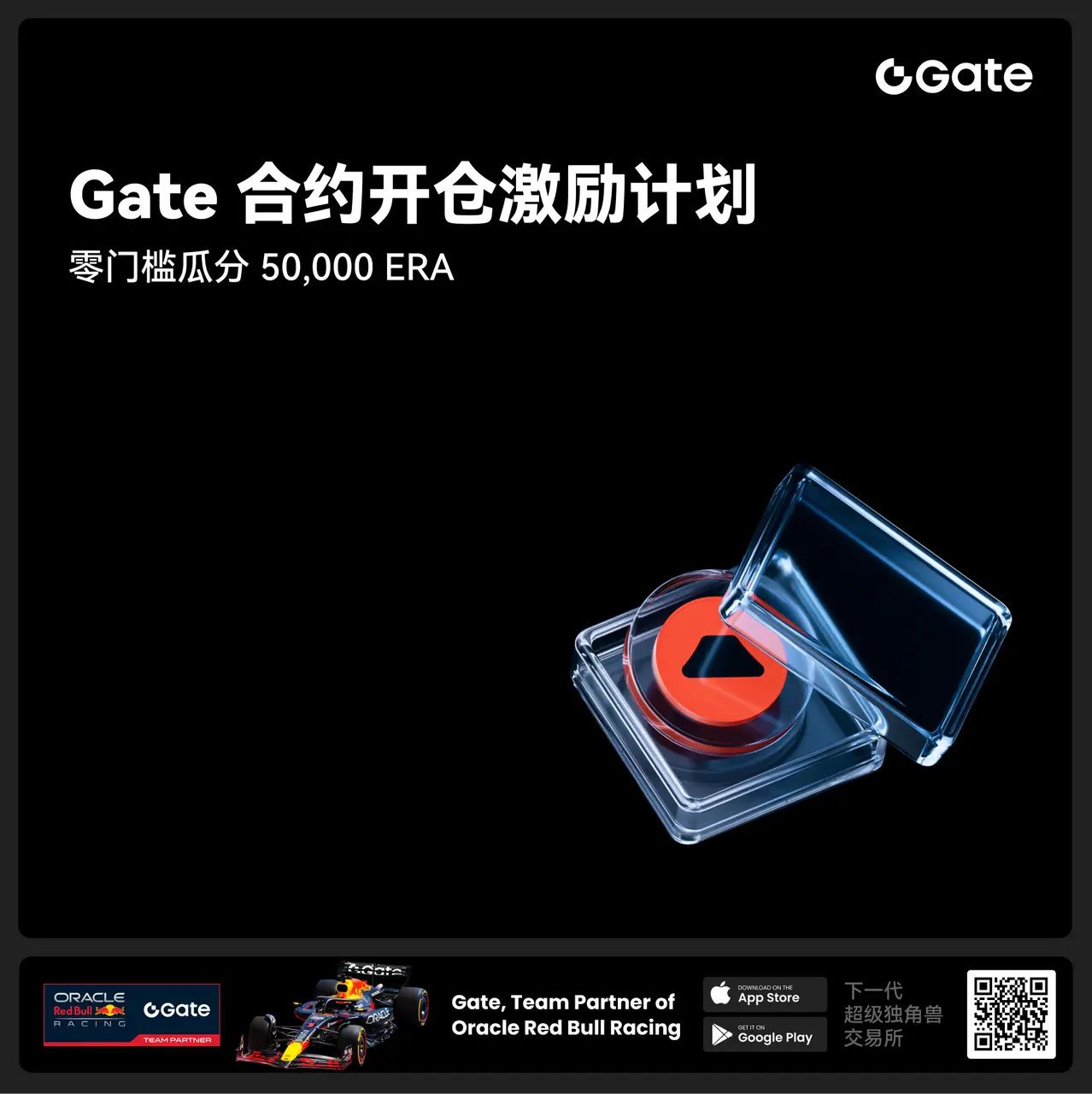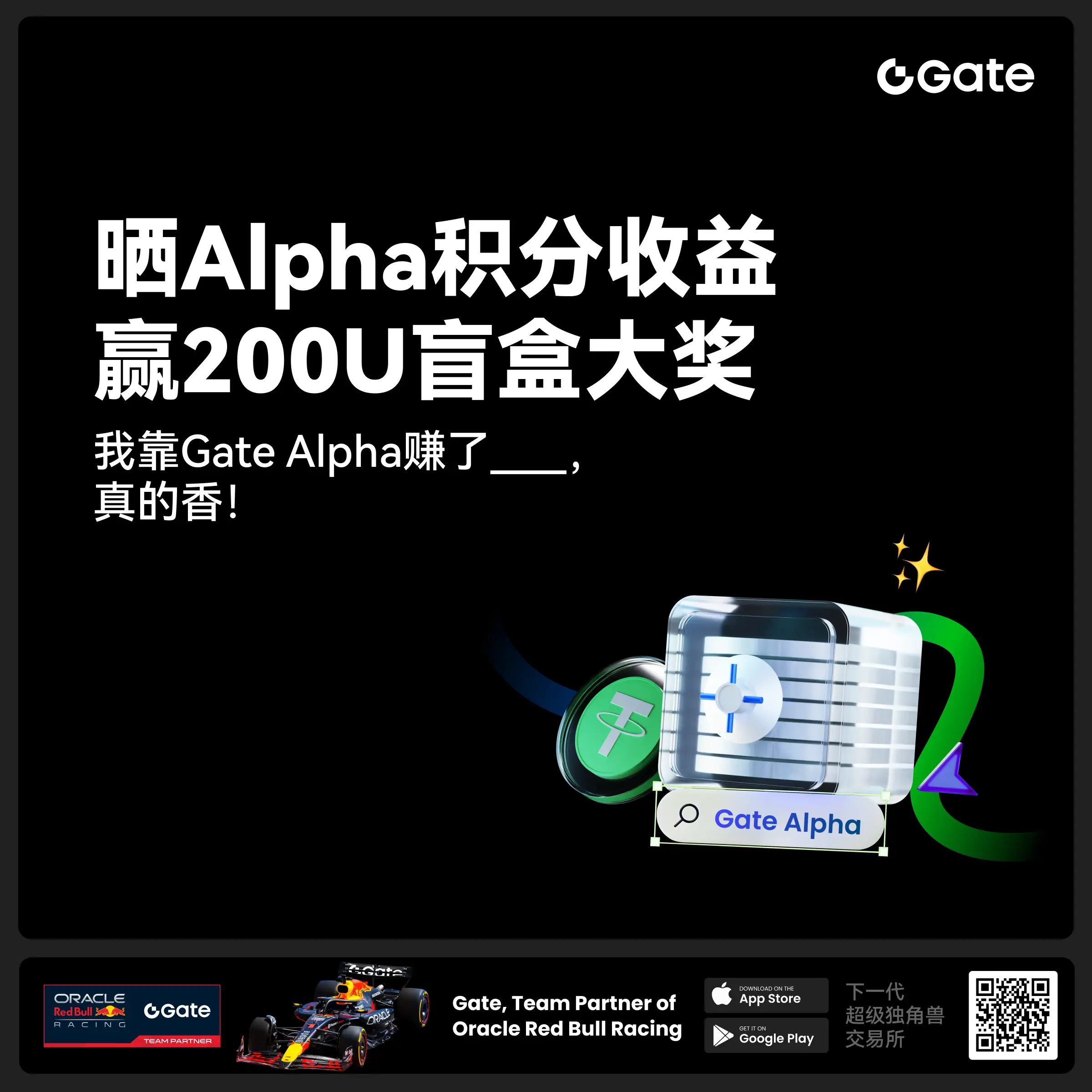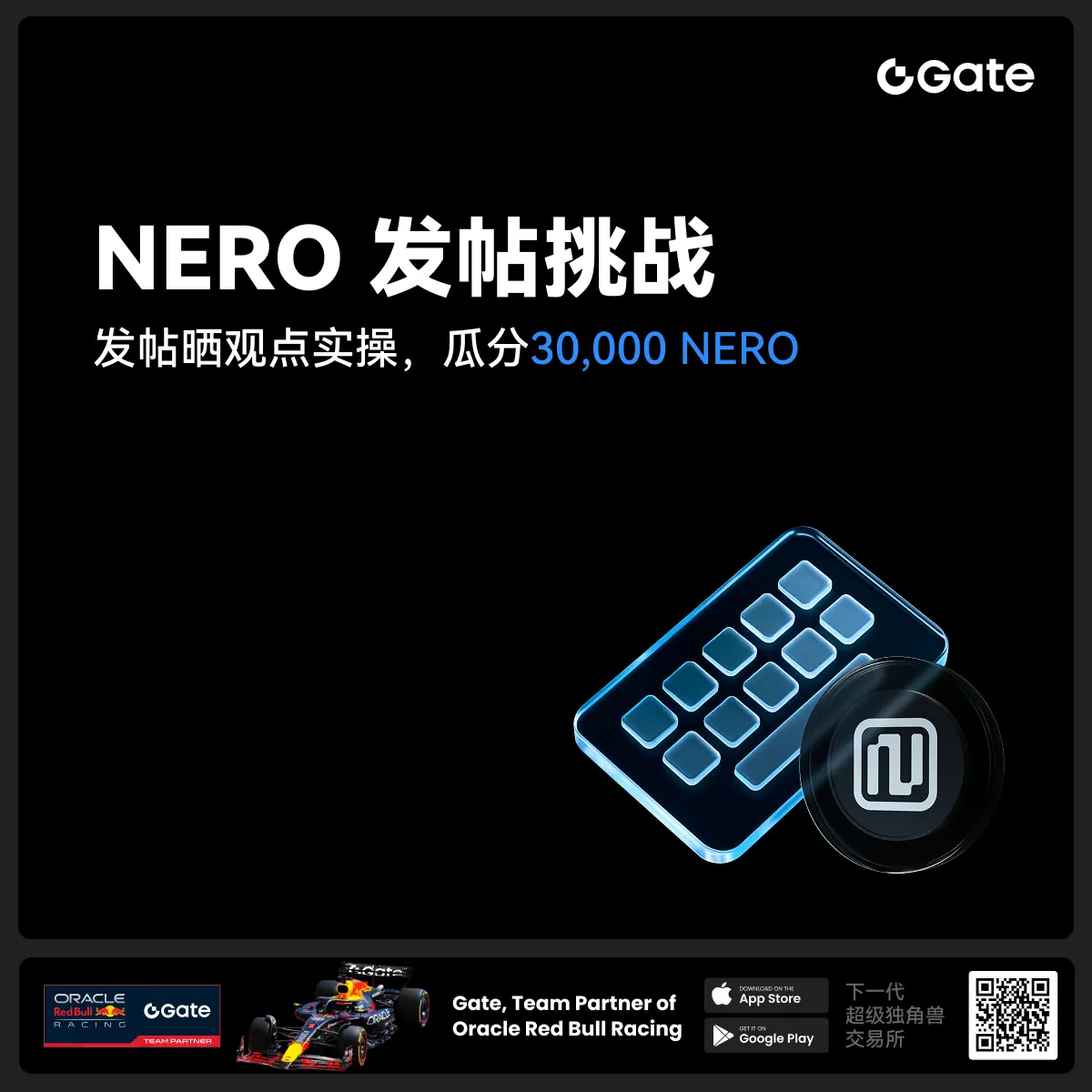- 話題1/3
19743 熱度
2305 熱度
2208 熱度
171459 熱度
33401 熱度
- 置頂
- Gate 合約開倉激勵計劃火熱上線!零門檻瓜分 50,000 ERA
開倉即有獎,交易越多獎勵越多!
新用戶享 20% 加成!
立即參與:https://www.gate.com/campaigns/1692?pid=X&ch=NGhnNGTf
活動詳情:https://www.gate.com/announcements/article/46429
#Gate # #合约交易 # #ERA#
- 👀 家人們,最近你們都攢了多少 Alpha 積分啦?
空投領到了沒?沒搶到也別急,廣場給你整點額外福利!
🎁 曬出你的 Alpha 收益,咱們就送你$200U代幣盲盒獎勵!
🥇 積分最高曬圖用戶 1 名 → $100 代幣盲盒
✨ 積分榜前五優質分享者 5 名 → 各得 $20 代幣盲盒
📍【怎麼玩】
1️⃣ 帶上話題 #晒出我的Alpha积分收益# 發廣場貼
2️⃣ 曬 Alpha 積分截圖 + 一句話總結:“我靠 Gate Alpha 賺了 ____,真的香!”
👉 還可以分享你的攢分技巧、兌換經驗、積分玩法,越乾貨越容易中獎!
📆【活動時間】
8月4日 18:00 - 8月10日 24:00 (UTC+8)
- 🎉 #CandyDrop合约挑战# 正式開啓!參與即可瓜分 6 BTC 豪華獎池!
📢 在 Gate 廣場帶話題發布你的合約體驗
🎁 優質貼文用戶瓜分$500 合約體驗金券,20位名額等你上榜!
📅 活動時間:2025 年 8 月 1 日 15:00 - 8 月 15 日 19:00 (UTC+8)
👉 活動連結:https://www.gate.com/candy-drop/detail/BTC-98
敢合約,敢盈利
- 🎉 攢成長值,抽華爲Mate三折疊!廣場第 1️⃣ 2️⃣ 期夏季成長值抽獎大狂歡開啓!
總獎池超 $10,000+,華爲Mate三折疊手機、F1紅牛賽車模型、Gate限量週邊、熱門代幣等你來抽!
立即抽獎 👉 https://www.gate.com/activities/pointprize?now_period=12
如何快速賺成長值?
1️⃣ 進入【廣場】,點擊頭像旁標識進入【社區中心】
2️⃣ 完成發帖、評論、點讚、發言等日常任務,成長值拿不停
100%有獎,抽到賺到,大獎等你抱走,趕緊試試手氣!
截止於 8月9日 24:00 (UTC+8)
詳情: https://www.gate.com/announcements/article/46384
#成长值抽奖12期开启#
- 📢 Gate廣場 #NERO发帖挑战# 秀觀點贏大獎活動火熱開啓!
Gate NERO生態周來襲!發帖秀出NERO項目洞察和活動實用攻略,瓜分30,000NERO!
💰️ 15位優質發帖用戶 * 2,000枚NERO每人
如何參與:
1️⃣ 調研NERO項目
對NERO的基本面、社區治理、發展目標、代幣經濟模型等方面進行研究,分享你對項目的深度研究。
2️⃣ 參與並分享真實體驗
參與NERO生態周相關活動,並曬出你的參與截圖、收益圖或實用教程。可以是收益展示、簡明易懂的新手攻略、小竅門,也可以是行情點位分析,內容詳實優先。
3️⃣ 鼓勵帶新互動
如果你的帖子吸引到他人參與活動,或者有好友評論“已參與/已交易”,將大幅提升你的獲獎概率!
NERO熱門活動(帖文需附以下活動連結):
NERO Chain (NERO) 生態周:Gate 已上線 NERO 現貨交易,爲回饋平台用戶,HODLer Airdrop、Launchpool、CandyDrop、餘幣寶已上線 NERO,邀您體驗。參與攻略見公告:https://www.gate.com/announcements/article/46284
高質量帖子Tips:
教程越詳細、圖片越直觀、互動量越高,獲獎幾率越大!
市場見解獨到、真實參與經歷、有帶新互動者,評選將優先考慮。
帖子需原創,字數不少於250字,且需獲得至少3條有效互動
新結構下的以太坊基金會:領導機制解析、存在哪些風險、Etheralize 是什麼?
作者 | Sam@IOSG
2025 年 3 月,以太坊基金會(Ethereum Foundation,簡稱 EF)宣布了一項重大領導層變動:執行董事 Aya Miyagotchi 卸下執行董事職責,轉任基金會主席;同時,Hsiao-Wei Wang 與 Tomasz Stańczak 被任命爲新的聯席執行董事;前EF研究員 Danny Ryan 加入 Etherealize。
面對激烈競爭,以太坊正面臨轉型時刻。這次變革不僅是一次人事調整,更像是一場圍繞以太坊未來走向的戰略博弈。長期以來,Aya 以理想化的願景推動以太坊構建“無限花園”。但隨着市場競爭加劇和高 Gas 費、網路擁堵等問題顯現,社區對其保守的資源分配與文化推廣策略產生了諸多質疑。甚至曾出現針對 Aya 的極端批評與攻擊,促使 Vitalik Buterin 出面呼籲冷靜。
在這種背景下,EF 通過調整領導層,既試圖回應外界的不滿,也力圖在理想主義與市場現實之間找到新的平衡。本文將從三個維度切入:EF組織架構的變革、Etherealize 的定位,以及 EF 近期的調整與未來展望,探討其戰略轉型迄今取得的成效。
一、雙重領導:權責新格局
Aya 任期
自 2018 年起,Aya Miyaguchi 擔任 EF 的執行董事。Aya 的領導恰逢 以太坊 從工作量證明向權益證明的重大轉型。
在戰略層面上,Aya 倡導並實施了被稱爲“減法哲學”的指導原則。這一原則要求基金會有意識地避免膨脹爲一個高度集中的權力機構,將更多機會和責任分散到整個社區。同時,EF 堅守開放、可信中立與去中心化的核心價值,避免了追逐利潤或採取激進市場營銷策略。
在內部結構調整方面,Aya 主導了多個新團隊和項目的設立。以 2022 年啓動的 EF Fellowship 計劃爲例,基金會通過該項目扶持新興社區中的建設者,助力“下一個十億”的願景。此外,自 2021 年起推出的 Devconnect 等新型會議形式,也顯示出EF在會議組織和社區建設上的新嘗試。
EF 架構與近期變動
以太坊基金會作爲一家非營利組織,其內部並非金字塔式層級結構,而是演化爲一個“團隊社區”。基金會爲衆多半自治團隊提供支持,這些團隊在各自擅長的領域內獨立運作,同時又在共同的價值觀指導下有機協作。
EF的組織架構可劃分爲四大職能板塊:協議研發(PR&D)、生態發展(EcoDev)、運營保障(Ops)與隱私與擴展探索( PSE)。各板塊既各司其職,又在“Protocol Guild”與“Protocol Support”團隊的協調下,與外部社區、研究機構及開發團隊協作。
基金會在協調跨團隊合作方面發揮着橋梁作用,例如組織客戶端互操作性研討會、推動網路升級以及承辦全球性活動如 Devcon。同時,EF 的管理層始終避免對每個項目進行微觀管理,而是鼓勵各團隊在“以自我爲主、各盡其責”的氛圍下開展工作。
負責協議核心研發的研究團隊也在 2024 年底至 2025 年初經歷了顯著變革。以太坊基金會研究部(EFR)於 2025 年初由原有單一研究團隊重組爲應用研究組(ARG)、共識研發組(Consensus R&D)、密碼學組(Cryptography)、協議安全組(Protocol Security)和激勵機制組(Robust Incentives Group, RIG)等五個專責小組。此番拆分源於基金會在密碼學與安全領域的快速擴張,需要更專業化的團隊聚焦不同研究方向,提升研發效率與透明度。同時,長期研究員 Alex Stokes 和 Barnabé Monnot 的上任聯席研究負責人,共同領導研究方向。
PSE 團隊作爲專注於零知識證明和隱私技術研究的關鍵小組,前身爲 EF 內部的 AppliedZKP 團隊,現已獨立爲跨學科“團隊社區”模式,與基金會其他半自治團隊平行運營。通過工作坊、夏令營、實驗網(如 Alphanet、Testnet)等多種形式助力以太坊網路朝着“隱私與擴展並重”的方向演進。PSE 的成立源於以太坊基金會對隱私與擴展技術實踐的迫切需求。過去零知識與 MPC 研究多停留在學術層面,PSE 應運而生以“應用驅動”方式推動技術成熟,填補研究與工程之間的鴻溝。在 2024 年,團隊經歷了一次重大重組。原有成員在當年晚些時候大批離職,團隊幾乎實現了“重啓”。
在最新的人事變動後,EF的管理架構爲:Aya 轉任主席,負責推動戰略合作及維護關係,將減少具體事務的直接參與;管理層方面,Hsiao-Wei Wang 和 Tomasz 擔任聯席執行董事,以平行協同的方式共同處理管理工作;在研究領域,Barnabé Monnot 與 Alex Stokes 將共同擔任聯席研究負責人,同時,Tju Liang Chua 繼續擔任 EF 的總法律顧問,而 Bastian 與 Josh Stark 則持續承擔 EF 的管理和運營職責。
現在 EF 主要的領導層如下:
Hsiao-Wei Wang 與 Tomasz:技術與管理的雙引擎
EF 在此次變革中引入了雙重領導架構,分別任命了兩位具備深厚技術背景和豐富實戰經驗的執行董事:
Hsiao-Wei Wang(王筱薇)
自 2017 年加入 EF 以來,王筱薇一直擔任核心研究員。她畢業於臺灣交通大學網路工程專業,擁有堅實的技術基礎。她深耕分片與信標鏈相關技,並在 2022 年的 The Merge 中發揮了關鍵作用。如今,擔任執行董事的王筱薇不僅負責引領研發方向,還肩負着推動社區建設的重要任務,她的任命被視爲以太坊重拾技術革新與草根精神的關鍵轉折。
Tomasz Stańczak
Tomasz 因在 Nethermind 的領導而廣爲人知。經過七年多的努力,Nethermind 在 Execution client 市場中目前僅次於 Geth,市場份額約爲 35%。與此同時,Nethermind 不斷拓展業務領域,推出各類產品並積極開展合作與研究,爲以太坊生態系統貢獻力量。Tomasz 不僅帶領 Nethermind 在客戶端開發上屢創佳績,他還積極探索 MEV 和 PBS 等前沿議題。Tomasz 在 Nethermind 積累的豐富經驗,爲 EF 注入了管理經驗和戰略眼光。
新架構旨在實現以下目標:
分散決策責任:兩位執行董事各自擁有獨立的全權決策空間,不僅降低了單點故障風險,也便於利益相關者根據自身偏好選擇對接對象。例如,身在歐洲的機構或開發者可根據 Tomasz 4–7 月的巡訪行程,直接與他會面、溝通。同時,這也讓利益相關者能夠靈活對接不同地區事務,自主把握合作節奏。
技術與管理優勢互補:王筱薇在以太坊核心創新(如信標鏈、分片技術及 ETH 2.0)方面的深入研究,與 Tomasz 在組織擴展與運營管理上的成熟經驗形成了強有力的互補。
Aya 轉任主席,Vitalik 回歸研究
與此同時,原執行董事 Aya Miyagotchi 轉任主席,更側重於外部戰略合作與關係維護。擔任七年執行董事的 Aya 現已專注於戰略指導與對外聯絡,而日常運營管理則由王筱薇和 Tomasz Stańczak 全面掌控。
據 Tomasz 披露,本次領導層更迭後的目標之一是讓 Vitalik 更多地投入到研究和探索中,而非日常協調或危機應對。Vitalik 近期關於 RISC-V、zkVMs 的文章開闢了有希望的研究方向,而他在隱私方面的論述也幫助社區重新對齊了 EF 的核心價值。同時,Vitalik 的提案雖具有重要分量,但更多是爲了引發討論、推動艱難研究領域的進展;社區評審可能大幅改動甚至否決這些提案。
社區反響
在新任命公布之後,以太坊社區對 Hsiao-Wei 和 Tomasz 表示祝賀與歡迎。
Paradigm 的首席技術官 Georgios Konstantopoulos 直言 Tomasz 達到了“新高度”:他智慧且經驗豐富,善於把握技術細微之處,具備建設並領導高效大團隊的能力。社區中普遍認爲 Hsiao-Wei 對協議的深入理解將確保基金會的技術方向始終掌握在專業人士手中。 Sassal 對此次聯合執行董事任命給予高度評價,並將這一領導層調整視爲推動 Ethereum 進入下一階段的“重大變革”。許多建設者都樂觀地預期,由一位來自研究領域的領導與一位來自工程及客戶端團隊的領導搭檔,將有助於在治理層面實現良好的平衡。
部分社區成員對 Danny Ryan 未能擔任 EF 主要領導職務表示驚訝。但就在同一周末,EF 宣布新任聯合執行董事的同時,Danny Ryan 也宣布作爲聯創加入 Etherealize。即便是曾持批評意見的聲音,如 Evan Van Ness,也在事後承認 Vitalik 的決策;他認爲盡管他曾期望看到 Danny 在 EF 中發揮更大作用,但新任聯合執行董事憑藉扎實的資歷和經驗,平息了此前的領導層爭議。
總的來說,圍繞 Aya Miyaguchi 離任的過渡期,社區內的討論雖曾激烈,但最終匯聚成了建設性的共識。社區成員認可 Aya 爲 EF 作出的貢獻,並有不少關鍵人物公開表達了對她的感謝;與此同時,對於新任 Hsiao-Wei Wang 與 Tomasz Stańczak 的引入,大家既寄予厚望,也期待新的領導架構能回應過去在溝通與技術協作方面的不足。
二、生態重構:Etherealize 的崛起
此前,社區內普遍期待 Danny Ryan 能直接接管 EF 執行董事的職位。然而,出乎預料的是,Danny Ryan 並未重返EF,而是以 Etherealize 聯合創始人的身分重返以太坊生態。這一選擇也暗示了另一種可能:組建一個類似 EF 的新型組織,以彌補 EF 的不足,專注於推動以太坊技術與商業潛力的真正落地。
正如 Danny Ryan 所言:“與其空談以太坊願景,不如展示如何讓機構切實利用以太坊。”在這一理念的指引下,他選擇了Etherealize — — 一個專注於以太坊生態商業擴展和市場營銷的平台。
核心使命
Etherealize 不僅僅是一個市場推廣工具,而是一個多維度的平台,其核心使命體現在以下 4 個方面:
· 機構接入與產品化
正如貝萊德 10 億美元鏈上美債和富蘭克林鄧普頓的共同基金,Etherealize 爲傳統金融機構提供”從概念設計到鏈上部署的全程護航”,顯著降低機構的試錯成本。
· 技術與市場結合
打通研發(R&D)與業務拓展(BD),快速迭代零知識證明、隱私模塊和跨 Rollup 橋接方案,並在真實客戶環境中即時驗證與優化。
· 政策倡導與監管對話
深度參與政策圓桌會議與參議院區塊鏈聽證會,發布《通俗版監管政策解讀》系列報告,分析穩定幣立法、代幣化證券規則及市場結構改革等議題。近期推動的“監管沙盒認證計劃”已吸引瑞士 FINMA 與新加坡 MAS 參與共建。
· 反饋與透明度
Etherealize 數據儀表盤實時追蹤鏈上核心指標(L2 總鎖倉價值、代幣化資產規模、結算延遲)與鏈下機構動態(合規認證進度、合作夥伴增長)。每月發布的《機構洞察》報告將客戶實操痛點直接轉化爲協議層優化需求。
雙軌架構
Etherealize 已正式分拆爲雙法律實體架構,以同步推進市場交付與生態治理。
營利實體 Etherealize Inc.(註冊於特拉華州的 C 類公司)專注於“爲銀行與資管機構等提供端到端代幣化服務、Layer2 部署方案與合規工具鏈”,其核心使命是通過標準化基礎設施降低傳統金融機構的上鏈門檻。
非營利實體 Etherealize Foundation 則着力“開放式研發、隱私工具開發與政策倡導架設現實世界與以太坊的橋梁”,重點維護以太坊的可信中立性與監管適配性。
這種雙軌模式推動 Etherealize 在運營前三個月內完成跨越式發展:營利部門成功落地貝萊德及富蘭克林鄧普頓鏈上共同基金項目;非營利部門同步開展監管圓桌會議,並試點基於零知識證明的隱私保護方案。“商業閉環+生態築基”的協同效應,推動着以太坊機構化進程進入加速階段。
Etherealize 起源
Etherealize 的概念最初源於 2024 年 7 月 23 日以太坊 ETF 啓動時,Grant Hummer 觀察到,盡管 ETF 推出標志着華爾街對以太坊的認可,但實際採用效果遠低於預期。這種落差促使他與投資人 James Fickle 合作尋找兼具華爾街經驗和以太坊知識的領導者,最終鎖定 Vivek Raman。
在獲得 Vitalik Buterin 與以太坊基金會的資助後,團隊於 2025 年 1 月正式成立,並迅速從純 BD 拓展到落地交付。隨後 Etherealize 意識到,撬動華爾街不僅需要理念傳播,更需提供無縫接入的實體工具。爲此 Vivek Raman 引入其摯友 Zach Obront,以聯合創始人身分重構技術基礎。最後,Danny Ryan 以首席戰略官,作爲最後一名聯創加入。
2025 戰略藍圖
在接受 Bankless 和 DeFi Dad 訪談時,Danny Ryan 分享了 Etherealize 的近期規劃,以下爲 2025 年核心路線圖:
Q2 推出機構級 SDK,集成托管接口、合規審查與 Gas 費優化模塊;
Q3 啓動基於 Noir 零知識編譯器的企業錢包試點;
Q4 進軍亞太與歐洲市場,通過與新加坡數字港、瑞士加密谷等合作定制監管適配方案。
在被問及項目路線圖及未來挑戰時,Danny 與 Vivek 闡述了應對策略:
以太坊 VS Solana:機構爭奪暗流
傳統金融界長期聚焦於以太坊及其二層生態系統,相比Solana,其技術應用上線更早、市場接受度更高。據 RWA.xyz 數據顯示,以太坊及其二層生態在 RWA 價值上佔比超過 50%。
在與傳統金融機構的合作中,由於以太坊較早上線,其生態系統已建立衆多合作案例:
Fidelity:Fidelity早在2018年成立了Fidelity Digital Assets,開始布局數字資產並提供比特幣托管服務。2019 年,其加密貨幣部門負責人 Tom Jessop 表達了對以太坊的濃厚興趣,指出公司在以太坊領域已投入大量資源。2024 年推出以太坊現貨 ETF(FETH)。
摩根大通:摩根大通於 2016 年推出了基於以太坊技術的開源企業帳本 Quorum,支持跨行信息網路和 JPM Coin 等項目。2022 年 11 月,在與新加坡央行合作的 Project Guardian 中,利用 Polygon 網路完成了首筆 DeFi 跨幣種交易。
高盛:2021 年,高盛在歐洲投資銀行(EIB)發行 1 億歐元數字債券時擔任聯合主承銷商,並利用以太坊智能合約實現證券和現金的代幣化。
匯豐:匯豐通過旗下的 HSBC Orion 平台,利用分布式帳本技術支持債券發行、數字黃金以及托管服務,同時實現了私有鏈與以太坊等公開鏈的互聯互通。
瑞銀:2024 年 11 月,瑞銀資產管理推出了首個在以太坊網路上發行的代幣化投資基金 — — “UBS USD Money Market Fund Token”(uMINT),將資金市場基金份額轉化爲鏈上代幣。2025 年初,瑞銀展示了基於以太坊二層 zkSync 的試驗成果,利用零知識證明技術實現部分黃金投資產品的拆分交易,並將零售黃金產品遷移至 zkSync “Validium”網路。
相比之下,Solana 與傳統金融機構合作較少。同時,Solana 上的 RWA 主要集中在穩定幣,其非穩定幣資產的比例低於以太坊。目前,主流的國債和其他基金項目如圖所示,相關項目的數量和金額均較少;同時,項目的品類較爲單一,還未覆蓋大規模的商品類 RWA 項目,以及私募信貸、私募股權等領域。
目前,以太坊平台在 RWA 資產價值上依然領先,其二層生態系統同樣承載了大量 RWA 資產,遠超其他公鏈項目。雖然市場上已有 6 只以太坊 ETF 獲批,而 Solana 相關 ETF 尚未獲得批準。但今年主流機構如 BlackRock 旗下的 BUIDL 和富蘭克林鄧普頓的 BENJI 已相繼在 Solana 上線,競爭日趨激烈。EF 也已確立明確的戰略布局應對挑戰,而 Etheralize 的成立更進一步彰顯了以太坊在尋求機構合作上的積極態度。
總結
正如 _gabrielShapir0 在評論中指出:“Etherealize 基本上可被視爲第二個 EF,這是一場文化和戰略上的分流,使以太坊變得更加社會化、多元化。”
實際上,Etherealize 標志着以太坊歷史上的一個關鍵政治時刻 — — 在此期間,文化分歧開始浮現。因此,以太坊的 L0 未來將更加注重社會化去中心化,就如同“客戶端多樣性”所體現的那樣。市場上也因此湧現出多種競爭的頂層戰略願景,從如何推廣 ETH 到未來發展方向,各具側重。
Etherealize 採用雙層架構,同時涵蓋盈利實體與非營利組織,爲其運作提供了更大的靈活性。兩部分各司其職,通力協作。其另一大優勢在於以技術爲驅動,聚焦產品本身,而非僅僅依賴商務拓展。正是這些特質,使 Etherealize 成爲一個高效且專注於對接傳統金融機構的平台。
三、EF 的近期調整與展望
盡管面臨諸多挑戰,以太坊仍具備支撐其加密領域地位的深厚優勢 — — 這些優勢常被其領導層淡化,致使負面批評掩蓋了其核心敘事。系統梳理這些優勢,有助於建立對以太坊潛力的客觀認知框架。
EF Silviculture Society:多元諮詢與內部革新
EF 推出了 Silviculture Society — — 一個由外部專家組成的非正式智庫,旨在爲基金會提供跨領域建議和多角度洞見。智庫成員來自技術、法律、學術和業界各領域,他們以一年爲期、無償參與,通過專門渠道向EF董事會提交保密意見,探索一套靈活多元的內部反饋機制。
疑慮
可能僅爲表面上的文化實驗,難以提升決策效率。
短期無償參與的模式或難以吸引具備長期深度洞見的專家,影響建議的持續性與專業性。
外部建議如何真正轉化爲內部決策尚不明確,反饋機制的透明度與執行力有待檢驗。
財務戰略與預算管理
在財務管理上,EF 推出了“每年花費剩餘資金 15%”的預算策略,以確保資金的長期可持續運作。據公開數據顯示,EF 國庫法幣資產從 2022 年 3 月的 12.94 億美元降至 2024 年 10 月的 7.84 億美元,而以 ETH 計價的持倉僅下降約 11%。與此同時,EF 的年度支出從 2021 年的 4800 萬美元上升至 2023 年 的 1.35 億美元,表明在生態支持、研發投入和人員薪資等方面投入不斷加大。
疑慮
EF持有大量 ETH,若 ETH 價格持續低迷,雖然 ETH 持倉下降幅度有限,但以美元計價的資產大幅縮水可能預示着財務健康存在隱患。
“剩餘資金 15%”策略雖具吸引力,但缺乏明確的執行細則,過去幾年策略未能有效貫徹,反而導致年度支出不斷上升。
年度開支急劇增加可能反映出資源分配效率低下,或顯示研發和資助成本持續攀升的問題。
具體的開支明細和資金使用計劃尚未完全公開,難以對運營狀況進行全面評估。
盡管巨額投入,實際成效尚未達到預期,顯示出內部管理與市場需求之間存在脫節。
跨足 DeFi 與生態創新
EF 宣布投入 50,000 ETH 參與 DeFi 項目,並通過新設立的多重籤名錢包進軍 DeFi 生態。同時,生態中湧現出 EtherStrategy 等全鏈上資產管理工具,以及“Second Foundation”新治理模式的討論,顯示出 EF 正探索多元化創新模式,推動生態系統持續進化。
問題與質疑
跨足 DeFi 同時質押 ETH,可能迫使 EF 在未來硬分叉等敏感議題上被迫表態,進而影響其作爲全球中立平台的定位。
市場質疑這種跨足行爲是否符合非營利機構的定位,是否會導致資源和戰略重心出現偏差,從而影響整體生態穩定性。
社交媒體與市場推廣
爲回應以往在社交媒體存在感不足的批評,EF 大力加強了各大平台的投入。從今年 1 月起,EF 重新激活了多個官方帳號,通過大量原創內容和動態轉發,及時傳遞內部改革和戰略舉措。同時,Vitalik Buterin 等核心人物通過更換頭像和頻繁互動,提升了以太坊品牌形象,在與傳統金融和政策制定者對話中強化“以太坊第一”的理念。
疑慮
社交媒體上的活躍表現可能僅停留在表面公關,無法解決內部治理和實際成果的問題。
市場推廣的實際效果及與傳統金融機構和實際應用的對接深度仍存在不確定性。
EF 資助
EF 在 2025 年推出了兩輪定時、主題化的專項資助 — — Pectra 前瞻性專項和 2025 學術資助,現均已截止;與此同時,ESP 的 小額資助(≤ $30 000,約兩周內決策)和 項目資助(無資金額上限、深度協作評審)繼續常年開放。
EF 戰略展望
管理層調整塵埃落定後,Vitalik 得以重心回歸研究;EF 也隨即和社區同步了下一階段的主要方向:一是 Tomasz 轉發與補充的整體路線圖,二是 Vitalik 提出的隱私路線圖。
就整體路線,簡化路線圖聚焦三大核心:
通過基於 Blob 的擴容提升數據處理能力;
通過定向協議升級提升L1吞吐量;
通過深化L2互操作性並聚焦應用層,改善用戶體驗。
同時 Tomasz 強調,除此之外,次要事項包括:
始終在 L1 上鑄造資產
贏得真實世界資產(RWA)和穩定幣市場
改進溝通並明確社區與用戶的預期
在千億級經濟體下大幅提升安全標準
在基金會內部推動目標驅動的研發
與此同時,Vitalik 在最新的“A maximally simple L1 privacy roadmap ()” 文章中,提出了他對的以太坊隱私路線圖的構想,覆蓋四種關鍵隱私形式:鏈上支付隱私,應用內活動的部分匿名化,鏈數據讀取隱和網絡層匿名化。
路線圖主要爲:
將 Railgun、Privacy Pools 等隱私工具原生集成到主流錢包,默認啓用“屏蔽餘額”與“從屏蔽餘額發送”;
推動“每個應用一個地址”設計,配合隱私保護的“自發交易”默認開啓;
實施 FOCIL 與 EIP-7701,簡化零重放、免中繼的抗審查交易;
在短期內於錢包中引入基於 TEE 的 RPC 隱私解決方案,未來逐步切換爲更具密碼學保證的 PIR;
錢包同時連接多個 RPC 節點(可選混網訪問),並推進輕客戶端支持,減少元數據泄露;
研發零知識證明聚合協議,壓縮隱私交易的 Gas 成本;
打造隱私感知的 keystore 錢包,讓用戶可在 L1/L2 間無縫升級籤名算法或驗證邏輯,同時保持私密性。
四、結語
以太坊生態正經歷一場由內而外的範式革新。雙重領導架構的引入實現了決策責任的分散,技術與管理優勢的互補,同時也使得 Viltaik 能抽身於運營實務,專注前沿研究並引領以太坊。EF 一些列變動,包括研究部的拆分,新上任的研究聯席,務實與效率優先的推行,以及積極參與 DeFi 和社交媒體運營等,都是很好的改變,展示了在激烈市場競爭中求變突破的決心。
Etherealize 的問世是戰略轉型的重要裏程碑。在與傳統金融機構的對接上,EF 因組織架構,定位和歷史等等原因,往往並非最佳選擇,也未能滿足市場的緊迫需求。而專爲機構客戶定制的 Etherealize,憑藉清晰的華爾街服務定位和靈活的組織架構,有效彌補了 EF 的短板,協助 EF 的工作而不增加其負擔。
至此,EF 和 Etherealize 已經爲以太坊帶來了組織架構上的革新和換血,使其更好應對在更激烈的競爭環境。而下一步的挑戰,是關於以太坊未來的核心挑戰:ETH 作爲資產的定位與敘事,以太坊生態系統的整合,性能和體驗的提升等。這些關乎根本的戰略難題,遠非組織調整或戰術性改進所能應對,將成爲檢驗新一代領導層的關鍵試金石。
盡管挑戰與疑慮依然存在,但這些變革無疑爲以太坊開闢了一條探索新可能的道路,標志着一個真正意義上面向未來的新紀元。